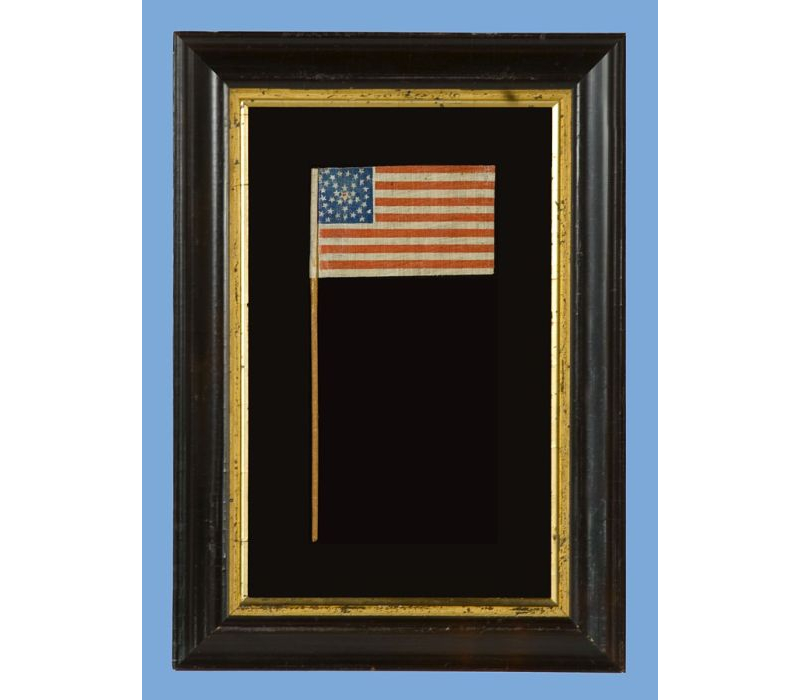
| |
36 STARS, 1864-1867, CIVIL WAR ERA, RARE "GREAT STAR-IN-A-WREATH" DESIGN, ONE OF THE BEST IN ALL OF FLAG COLLECTING |
|
| Available: |
Sold |
| Frame Size (H x L): |
13.25" x 9.5" |
| Flag Size (H x L): |
2.25" x 3.75" on a 7.5" staff |
|
| Description....: |
|
36 STARS, 1864-1867, CIVIL WAR ERA, RARE "GREAT STAR-IN-A-WREATH" DESIGN, ONE OF THE BEST IN ALL OF FLAG COLLECTING:
36 star American parade flag, printed on glazed cotton, with one of the most rare and beautiful star configurations ever produced. This is comprised of what is known as a "Great Star" star configuration (a star made out of stars), which has a large central star. The Great Star is set within a wreath of stars and is flanked by two stars in each corner. As far as I am aware, the design is unique to this variety of parade flag. There are other known combinations of the Great Star and wreath designs in printed flags, but none have two stars in each corner, which is an exceptionally rare feature. While tiny in size, this could easily be defended as the best geometric star pattern in all of parade flag collecting.
To the best of my knowledge, only one group of these parade flags has ever been found. They were discovered at an auction of the contents of an extremely large working farm (called Normandy Farm) in Eastern Montgomery County, Pennsylvania. The farm belonged to an eccentric member of the Singer Sewing Machine family, who personally did not live on the estate, and rather chose to live nearby in a 1950's style motel. The contents included belongings of this family that were accumulated over 150 years since it was reported that "nothing was ever discarded by them....just placed in storage in attics, lofts, or out buildings." Besides the usually working farm buildings, there were other houses and storage buildings on the property. The auction included multiple auctioneers working simultaneously for 3 entire days, but could not sell all the miscellaneous boxes that remained. The flags were discovered in a box of holiday decorations that were sold to an antique toy dealer, from whom they were subsequently acquired.
These flags were most likely were used by children at a parade or celebration welcoming home Union soldiers traveling through this area at the conclusion of the Civil War. They might also have been produced for the campaign of Abraham Lincoln, or for the mourning of his death.
The 36th state, Nevada, entered the Union during the Civil War on October 31st, 1864. The last Confederate general surrendered on May 26th, 1865. The 36 star flag became official on July 4th of that year, but makers of printed flags would have begun adding a 36th star to their flags in 1864, even before the addition of the new state occurred. Lincoln pushed Nevada through just 8 days before the November election to increase his support. While the population of the state was quite small, its primary industry was silver mining and the political alignment was generally Republican. The 36 star flag was replaced by the 37 star flag in 1867, with the addition of Nebraska.
Mounting: The flag has been stitched to 100% cotton, black in color, which was washed to reduce excess dye. An acid-free agent was added to the wash to further set the dye and the fabric was heat-treated for the same purpose. The mount was then placed in a paint-decorated and gilded molding that dates to the period between 1840 and 1870. Spacers keep the textile away from the glass, which is u.v. protective. |
|
|
|
| Collector Level: |
Advanced Collectors and the Person with Everything |
|
| Flag Type: |
Parade flag |
|
| Star Count: |
36 |
|
| Earliest Date of Origin: |
1864 |
|
| Latest Date of Origin: |
1867 |
|
| State/Affiliation: |
Pennsylvania |
|
| War Association: |
1861-1865 Civil War |
|
| Price: |
SOLD |
|
| |
Views: 2941 |
|
|
|

